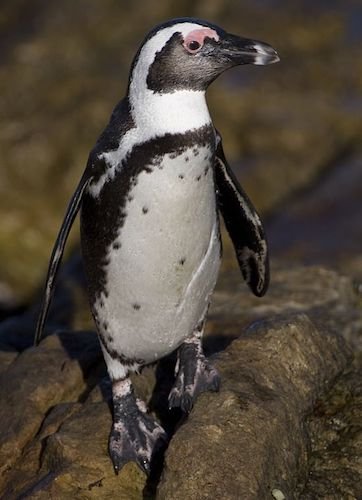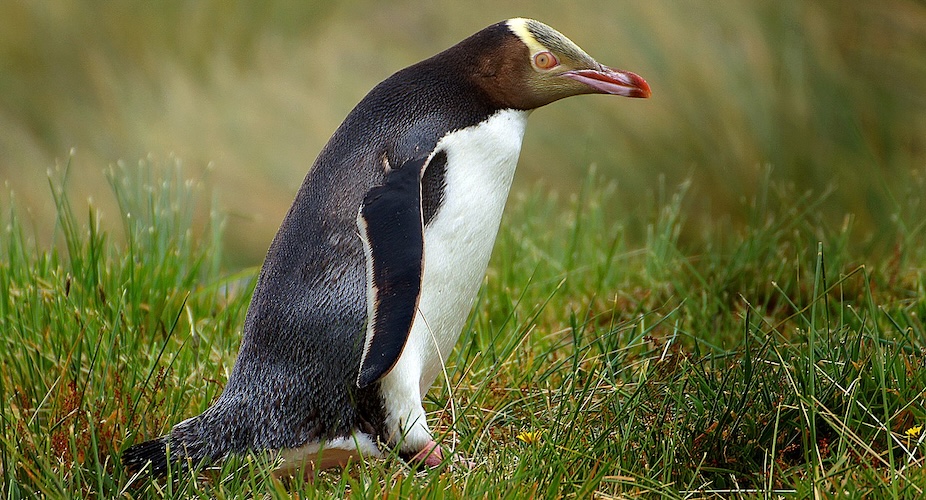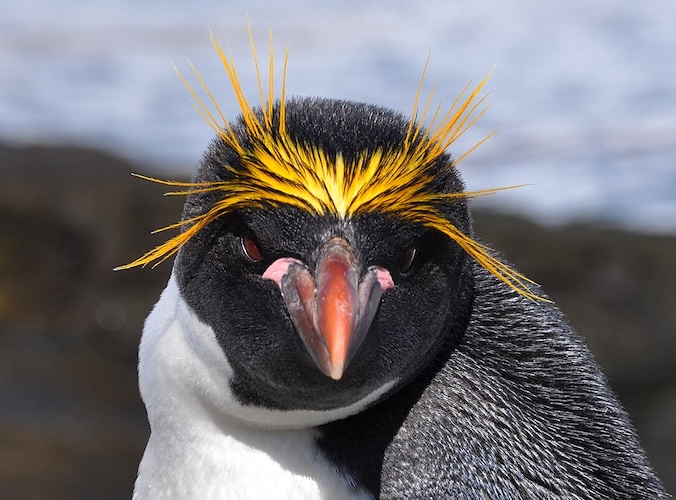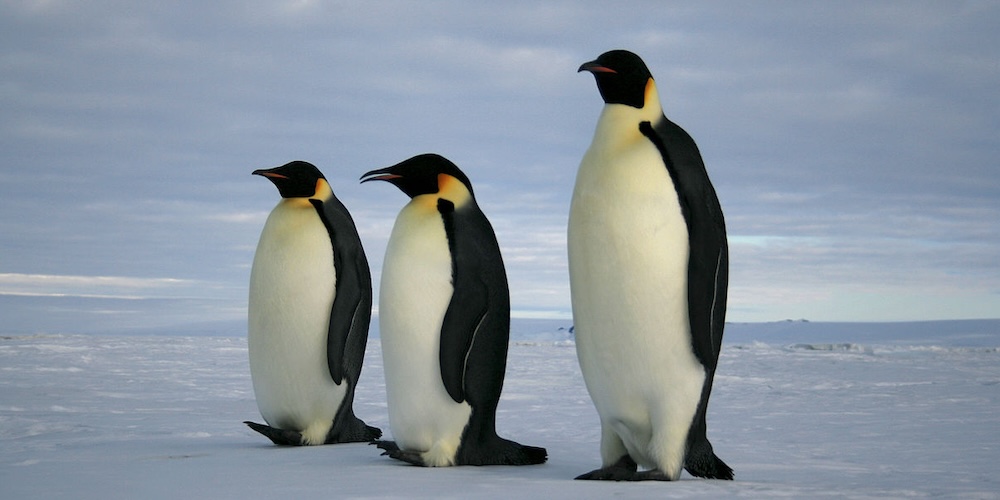Spheniscidae – Penguins

The Spheniscidae or Penguins (order Sphenisciformes) are a group of aquatic, flightless birds. They live almost exclusively in the Southern Hemisphere, with only one species, the Galapagos Penguin, found north of the equator. Highly adapted for life in the water, penguins have countershaded dark and white plumage, and their wings have evolved into flippers. Most penguins feed on krill, fish, squid and other forms of sea-life caught while swimming underwater. They spend about half of their lives on land and half in the oceans.
Although almost all penguin species are native to the Southern Hemisphere, they are not found only in cold climates, such as Antarctica. In fact, only a few species of penguin live so far south. Several species are found in the temperate zone, and one species, the Galápagos Penguin, lives near the equator.
The largest living species is the Emperor Penguin Aptenodytes forsteri: on average adults are about 1.1m tall and weigh 35kg or more. The smallest penguin species is the Little Blue Penguin Eudyptula minor, also known as the Fairy Penguin, which stands around 40cm tall and weighs 1kg. Among extant penguins, larger penguins inhabit colder regions, while smaller penguins are generally found in temperate or even tropical climates. Some prehistoric species attained enormous sizes, becoming as tall or as heavy as an adult human. These were not restricted to Antarctic regions; on the contrary, subantarctic regions harboured high diversity, and at least one giant penguin occurred in a region not quite 2,000km south of the equator, in a climate decidedly warmer than today.

Yellow-eyed Penguin Megadyptes antipodes – ©Bernard Spragg via Wikimedia Commons
Although almost all penguin species are native to the Southern Hemisphere, they are not found only in cold climates, such as Antarctica. In fact, only a few species of penguin actually live so far south. Several species live in the temperate zone; one, the Galápagos penguin, lives as far north as the Galápagos Islands, but this is only made possible by the cold, rich waters of the Antarctic Humboldt Current that flows around these islands.
Several authors have suggested that penguins are a good example of Bergmann’s Rule where larger bodied populations live at higher latitudes than smaller bodied populations. There is some disagreement about this, and several other authors have noted that there are fossil penguin species that contradict this hypothesis and that ocean currents and upwellings are likely to have had a greater effect on species diversity than latitude alone. Major populations of penguins are found in Antarctica, Argentina, Australia, Chile, New Zealand, and South Africa.

Macaroni Penguin Eudyptes chrysolophus – ©Butterfly voyages Serge Ouachée CC BY-SA 3.0 via Wikimedia Commons
Penguins for the most part breed in large colonies, the exceptions being the yellow-eyed and Fiordland species; these colonies may range in size from as few as 100 pairs for Gentoo penguins, to several hundred thousand in the case of King, Macaroni and Chinstrap penguins. Living in colonies results in a high level of social interaction between birds, which has led to a large repertoire of visual as well as vocal displays in all penguin species. Agonistic displays are those intended to confront or drive off, or alternately appease and avoid conflict with, other individuals.
They form monogamous pairs for a breeding season, though the rate the same pair re-couples vary drastically. Most penguins lay two eggs in a clutch, although the two largest species, the Emperor and the King penguins, lay only one. With the exception of the Emperor penguin, where the male does it all, all penguins share the incubation duties. These incubation shifts can last days and even weeks as one member of the pair feeds at sea.

Emperor Penguin Aptenodytes forsteri – ©lin padgham CC BY 2.0 via Wikimedia Commons
They generally only lay one brood; the exception is the Little Penguin, which can raise two or three broods in a season. Penguin eggs are smaller than any other bird species when compared proportionally to the weight of the parent birds; at 52g, the little penguin egg is 4.7% of its mothers’ weight, and the 450g emperor penguin egg is 2.3%. The relatively thick shell forms between 10% and 16% of the weight of a penguin egg, presumably to minimise the risk of breakage in an adverse nesting environment. The yolk, too, is large, and comprises 22–31% of the egg. Some yolk often remains when a chick is born, and is thought to help sustain the chick if the parents are delayed in returning with food.
When mothers lose a chick, they sometimes attempt to ‘steal’ another mother’s chick, usually unsuccessfully as other females in the vicinity assist the defending mother in keeping her chick. In some species, such as emperor penguins, young penguins assemble in large groups called crèches.
-
Number of bird species: 19
(As at August 2025)
According to the recently (2025) combined AviList, there are nineteen species, in six genera, in the family Spheniscidae – Penguins; they are:
King Penguin Aptenodytes patagonicus
Emperor Penguin Aptenodytes forsteri
Adelie Penguin Pygoscelis adeliae
Gentoo Penguin Pygoscelis papua
Chinstrap Penguin Pygoscelis antarcticus
Little Penguin Eudyptula minor
African Penguin Spheniscus demersus
Humboldt Penguin Spheniscus humboldti
Galapagos Penguin Spheniscus mendiculus
Magellanic Penguin Spheniscus magellanicus
Yellow-eyed Penguin Megadyptes antipodes
Fiordland Penguin Eudyptes pachyrhynchus
Erect-crested Penguin Eudyptes sclateri
Macaroni Penguin Eudyptes chrysolophus
Royal Penguin Eudyptes schlegeli
Southern Rockhopper Penguin Eudyptes chrysocome
Eastern Rockhopper Penguin Eudyptes filholi
Northern Rockhopper Penguin Eudyptes moseleyi
Snares Penguin Eudyptes robustus
-
Southern Oceans Seabird Study Association
WebsiteSOSSA was founded by members of the New South Wales Albatross Study Group (NSWASG) in 1994. It was set up to be an umbrella organisation for many study groups concerned with studies of Southern Ocean bio-diversity. SOSSA is a wildlife research and conservation group which consists of dedicated people both professional and amateur. These people share a common interest and concern for the environment and the wildlife of the Southern Oceans -
The Seabird Group
WebsiteThe Seabird Group, a registered charity, was founded in 1966 to promote and help coordinate the study and conservation of seabirds -
Yellow-eyed Penguin Trust
WebsiteIn the 1980s research on the Otago Peninsula showed that the penguin population had declined severely, and that the yellow-eyed penguin was now considered to be an endangered species. This was due to severe predation and loss of habitat
-
Penguins of the World
| By Wayne Lynch | A & C Black | 2007 | Edition 2 | Hardback | 175 pages, Colour photos, maps | ISBN: 9780713687118 Buy this book from NHBS.com -
Seabirds
| By Peter Harrison | Christopher Helm | 1991 | Hardback | 448 pages, 324 distribution maps, 88 colour plates, line drawings | ISBN: 9780713635102 Buy this book from NHBS.com -
Seabirds - a natural history
| By Anthony J Gaston | A&C Black | 2004 | Hardback | 222 pages, 22 colour plates, b/w photos, illustrations, figures | ISBN: 9780713665574 Buy this book from NHBS.com
-
Spheniscidae
Family AccountPenguins are a group of aquatic flightless birds from the family Spheniscidae of the order Sphenisciformes -
Spheniscidae
Family AccountThere are 18 species of birds in this family. Penguins are found in the Southern Hemisphere from the Antarctic to the equator.
Given that this is a relatively small family with just nineteen species in only six genera, Fatbirder provides active links below to all species.
-
Adelie Penguin Pygoscelis adeliae
Species AccountThe Adélie penguin (Pygoscelis adeliae) is a species of penguin common along the entire Antarctic coast, which is their only residence. They are among the most southerly distributed of all seabirds, along with the emperor penguin, the south polar skua, the Wilson's storm petrel, the snow petrel, and the Antarctic petrel. -
Adelie Penguin Pygoscelis adeliae
Species AccountPygoscelis adeliae is listed as Least Concern. -
Adelie Penguin Pygoscelis adeliae
Species AccountSound archive and distribution map. -
African Penguin Spheniscus demersus
Species AccountThe African penguin (Spheniscus demersus), also known as the jackass penguin and black-footed penguin is a species of penguin, confined to southern African waters. I -
African Penguin Spheniscus demersus
Species AccountSpheniscus demersus is listed as Critically Endangered under criteria A3bce+4bce. -
African Penguin Spheniscus demersus
Species AccountSound archive and distribution map. -
Chinstrap Penguin Pygoscelis Antarctica
Species AccountChinstrap penguins are white on the front and throat but have a black back. Chinstraps are easily distinguished by the thin black stripe across the bottom of the throat - the infamous chinstrap -
Chinstrap Penguin Pygoscelis Antarctica
Species AccountSound archive and distribution map. -
Eastern Rockhopper Penguin Eudyptes filholi
Species AccountSound archive and distribution map. -
Eastern Rockhopper Penguin Eudyptes filholi
Species AccountThe eastern rockhopper penguin (Eudyptes filholi), also known as the tawaki piki toka (Māori: 'rock climber'), is a crested penguin with yellow crest -
Emperor Penguin Aptenodytes forsteri
Species AccountThe emperor penguin (Aptenodytes forsteri) is the tallest and heaviest of all living penguin species and is endemic to Antarctica. -
Emperor Penguin Aptenodytes forsteri
Species AccountSound archive and distribution map. -
Erect-crested Penguin Eudyptes sclateri
Species AccountThe erect-crested penguin (Eudyptes sclateri; Māori: Tawaki nana hī) is a penguin endemic to the New Zealand region... -
Erect-crested Penguin Eudyptes sclateri
Species AccountSound archive and distribution map. -
Fiordland Penguin Eudyptes pachyrhynchus
Species AccountTall penguin endemic to New Zealand, with distinct broad yellow eyebrow that spreads out and sags down the neck. -
Fiordland Penguin Eudyptes pachyrhynchus
Species AccountSound archive and distribution map. -
Galapagos Penguin Spheniscus mendiculus
Species AccountThe Galapagos penguin is one of the smallest penguins in the world and is endemic to the Galapagos Islands. -
Galapagos Penguin Spheniscus mendiculus
Species AccountSound archive and distribution map. -
Gentoo Penguin Pygoscelis papua
Species AccountSound archive and distribution map. -
Gentoo Penguin Pygoscelis papua
Species AccountAttractive, medium-sized penguin that is rarely seen away from well-known colony sites. -
Humboldt Penguin Spheniscus humboldti
Species AccountThe Humboldt penguin (Spheniscus humboldti) is a medium-sized penguin. It resides in South America, along the Pacific coast of Peru and Chile. -
Humboldt Penguin Spheniscus humboldti
Species AccountSound archive and distribution map. -
King Penguin Aptenodytes patagonicus
Species AccountThe king penguin (Aptenodytes patagonicus) is the second largest species of penguin, smaller than but somewhat similar in appearance to the emperor penguin. -
King Penguin Aptenodytes patagonicus
Species AccountSound archive and distribution map. -
Little Penguin Eudyptula minor
Species AccountThe little penguin (Eudyptula minor) is the smallest species of penguin. It originates from New Zealand. -
Little Penguin Eudyptula minor
Species AccountSound archive and distribution map. -
Macaroni Penguin Eudyptes chrysolophus
Species AccountMedium-sized bulky penguin with a bulbous red bill and a dash of stiff orange “hair.” -
Macaroni Penguin Eudyptes chrysolophus
Species AccountSound archive and distribution map. -
Magellanic Penguin Spheniscus magellanicus
Species AccountThe Magellanic penguin (Spheniscus magellanicus) is a South American penguin, breeding in coastal Argentina, Chile and the Falkland Islands, with some migrating to Brazil where they are occasionally seen as far north as Rio de Janeiro. It is the most numerous of the Spheniscus penguins. Its nearest relatives are the African, the Humboldt penguin and the Galápagos penguins. -
Northern Rockhopper Penguin Eudyptes moseleyi
Species AccountThe northern rockhopper penguin, Moseley's rockhopper penguin, or Moseley's penguin (Eudyptes moseleyi) is a penguin species native to the southern Indian... -
Northern Rockhopper Penguin Eudyptes moseleyi
Species AccountSound archive and distribution map. -
Royal Penguin Eudyptes schlegeli
Species AccountThe royal penguin (Eudyptes schlegeli) is a species of penguin, which can be found only on the sub-Antarctic Macquarie Island and adjacent islands. -
Royal Penguin Eudyptes schlegeli
Species AccountSound archive and distribution map. -
Snares Penguin Eudyptes robustus
Species AccountThe Snares penguin (Eudyptes robustus), also known as the Snares crested penguin and the Snares Islands penguin, is a penguin from New Zealand. The species breeds on The Snares, a group of islands off the southern coast of the South Island. -
Snares Penguin Eudyptes robustus
Species AccountThe Snares crested penguin is one of eight similar-looking species of crested penguins, all of which have occurred in New Zealand, and four of which breed here. -
Southern Rockhopper Penguin Eudyptes chrysocome
Species AccountThe rockhopper penguins are three closely related taxa of crested penguins that have been traditionally treated as a single species and are sometimes split into two or three species. -
Yellow-eyed Penguin Megadyptes antipodes
Species AccountThe yellow-eyed penguin (Megadyptes antipodes), known also as hoiho, is a species of penguin endemic to New Zealand. -
Yellow-eyed Penguin Megadyptes antipodes
Species AccountSound archive and distribution map.
-
Hedwig's Penguin Home
WebsiteA site about penguins with a lot of information (biology, anatomy, enemies, names, breeding, etc.); pictures, books, and a lot more. In Dutch and English.
